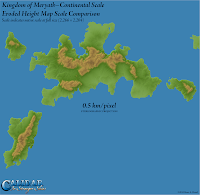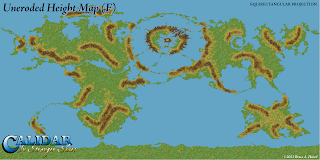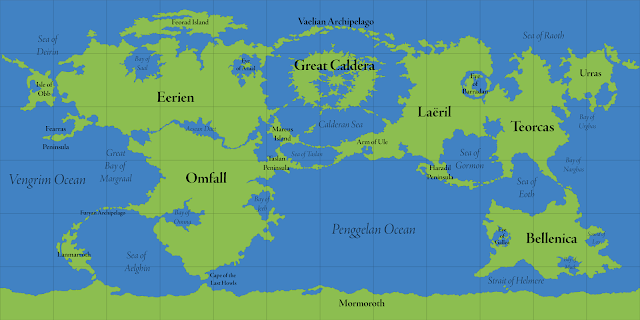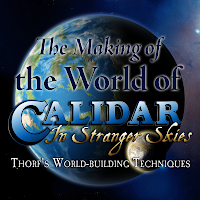 |
This is the second article in a series.
Click here for the series index. |
The first step in creating a whole world is to create a set of continental outlines. There is good reason to make this the first step: at this point, it's a simple matter to make tweaks and adjustments until you have things looking just the way you want. The further you progress through your world-building project, the more troublesome this will become, so that later on even a minor tweak may potentially require time-consuming revisions to be made throughout your work.
To sum up: now is the time to try things out, reject what you don't like, keep what you do, and most importantly keep tweaking until you get things just right.
Concepts
Before we get started, there are some things to bear in mind when creating our world map. First and foremost, the world map is necessarily an extremely small scale map. Consequently, it cannot show your world in very high detail; nor does it need to. In many respects, world maps are vague and inaccurate. They simply lack the kind of resolution needed to display high levels of detail. In layman's terms, they are just too far zoomed out to see much more than general shapes.
What this means is that your world map is your base map, upon which all other maps are based, but regional and local maps do not have to reflect it 100%. On the contrary, they should develop and expand upon the foundations contained in the world map, introducing new details too fine to show up on it, as well as revising and enhancing those details that did appear on the world map.
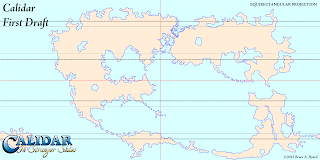 |
+Bruce Heard's very first design for Calidar's world map. Note
how the Great Caldera is already present, but joined up with the
adjacent continents. This map was drawn directly onto a 2:1
Equirectangular Projection using Paint.NET. The resolution
was 6000 x 3000.
|
Generally, regional maps will be created by cropping your world map, then resampling to a higher resolution. Local maps can then be done in the same way, based on regional maps. With Calidar, I increase resolution by a factor of four for regional maps, then increase by a factor of four again for local maps.
If you deem it necessary, the world map can be rebuilt later to reflect the more detailed regional maps, but this should be considered strictly optional. There is probably not a lot to be gained by doing so, as the lower resolution of the world map will obscure the added details anyway. In general, world maps should remain reasonably simple and unburdened with tiny details, to fulfil their main purpose as overview maps.
Software
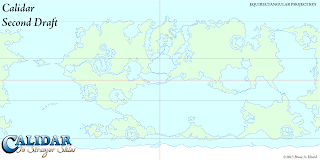 |
Bruce's second draft incorporated impact craters throughout the
world, so that there were numerous areas like the Great Caldera.
It also split the Great Caldera from its neighbouring continents. |
When it comes to drawing the actual outlines, pretty much any paint software will do - raster or vector. Personally I like Adobe Illustrator's vectors for this stage, but Adobe Photoshop or an equivalent raster editor is just as effective. You can go back and forth between raster and vector using auto-trace when necessary.
The reason for this is that at this stage, only the general shapes are important; small details on the coasts can be added later, so there's no need to worry about things looking too regular.
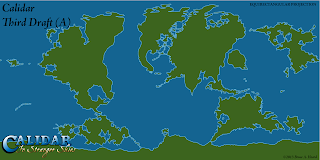 |
I took a stab at the third draft, tracing Bruce's outlines to Illustrator
vectors. I went back to the first draft and tried to split things up to
look more earth like. |
It's worth noting here briefly the differences between raster and vector art.
Raster graphics, also known as bitmaps, are comprised of arrays of tiny dots known as pixels. Most people are familiar with these images from photographs, paint programs, and indeed the Internet. Common formats are PNG, JPG, and GIF. Photoshop and most other paint programs mostly work with raster images. Raster images can often be shrunk down without incurring great problems, but enlarging them causes them to become blocky and/or blurry, and is best avoided. This means that you need to consider what resolution to work in from the start, because you won't be able to increase it later on.
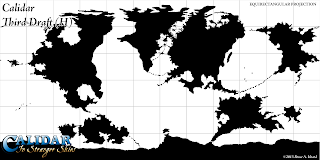 |
My last attempt. Note how we worked in a range of colour schemes;
at this stage in the design, working with whatever's easiest for you is fine.
Although these drafts were all ultimately rejected, you can see elements
of the final design slowly appearing. At this stage, Bruce realised that the
design had wandered away from the central concept of the Great Caldera
being a safe haven, isolated from the Dread Lands around about, and we
went back to the drawing board. |
Vector graphics, in contrast, are made up of mathematical descriptions of lines and points. They don't use pixels at all, although they can be rasterised – i.e. changed into pixel arrays. Because they are defined using lines and points, it's possible to resize them freely without losing sharpness. Fonts are probably the most common vector graphics encountered in daily life. Illustrator works primarily with vector graphics. Vector formats include SVG, DXG, AI, and many others.
In Calidar’s case, Bruce worked with PNG raster images in Paint.NET. I then auto-traced those images in Illustrator, turning them into vectors, before making adjustments and exporting to PNG to send back to Bruce. I prefer vectors for coastlines, but lately I have been using high resolution raster PNG files more and more, because it's easier to roughen coastlines on a raster image.
Projections
Images in this section are courtesy of USGS. Check their Map Projections Poster for a full description of all the concepts in this section.
 |
| Miller Cylindrical |
Planets are three dimensional objects: spheres, or more accurately ellipsoids. Maps, on the other hand, are flat two dimensional representations. When you make a two dimensional representation of a three dimensional planet, distortion of some kind is unavoidable.
 |
| Lambert Conformal Conic |
In order to create a flat map from an ellipsoid, a projection is needed. There are various kinds of projection, depending on how coordinates on the ellipsoid are mapped to coordinates on the map. The three basic types are cylindrical, conic, and azimuthal. There are other types; for example, pseudocylindrical projections are commonly used for presenting world maps in modern atlases.
 |
| Stereographic (Azimuthal) |
It’s important to understand that no projection can accurately represent every property of an ellipsoid. All projections introduce distortion of some kind. In fact, each projection can generally only preserve one or two properties. This is what guides the choice of projection for each map.
Properties that can be preserved include:
• Shape
• Area
• Distance
• Direction
• Bearing
• Scale
Of these, shape, area and distance are probably the most important, and projections that preserve them are the most well-known and widely used.
 |
| Albers Equal Area |
 |
| Robinson |
A fourth kind of projection that sees a lot of use is the category of Compromise Projections. These projections don’t preserve any property perfectly, instead aiming to strike a balance between distortions in multiple properties. Examples include Robinson, Van der Grinten, Miller, Winkel Tripel, and Dymaxion.
 |
| Normal Aspect Mercator |
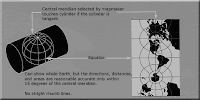 |
| Transverse Aspect Mercator |
Finally, another important property of projections is their aspect. There are three aspects: normal, transverse, and oblique. Aspect refers to the orientation of the base plane of the projection to the ellipsoid. Normal aspect means that it is aligned with the “normal” view of the planet. In the case of a cylindrical projection, it’s easy to imagine the earth inside a vertical tube, with the tube touching the cylinder at the equator. Transverse means that the cylinder is horizontal, touching a meridian instead of the equator. Transverse projections are therefor at a 90º angle to normal projections. Oblique means that it is angled somewhere between normal and transverse, which means that the cylinder doesn’t correspond to any parallel or meridian.
Advantages of Projections
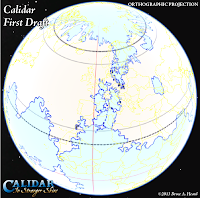 |
Bruce's original world map design as an
image overlay in Google Earth |
If you don’t care about projections, you’re good to go - draw your world map in whatever shape you like, and stick with it. Many fantasy cartographers do just this, and produce stunning works of art without ever worrying about what projection the map is in. There’s nothing wrong with this approach – we are dealing with fantasy, after all. All fantasy cartographers sacrifice some aspect or other in order to produce maps in a reasonably timely fashion, and I would hate to force my style on someone else just for the sake of “accuracy”.
With that said, there are quite a few advantages to using projections in your maps, should you wish to do so. For example, you will be able to:
• Take advantage of reprojection techniques to design good-looking polar areas, avoiding distortion and spikiness.
• Produce multiple versions of your world map, choosing a projection to match the theme of each.
 |
Icosahedral net made in Fractal Terrains
using an Equirectangular height map |
• Choose suitable projections to show each region of your world in its “true” shape.
• Take advantage of the properties of each projection in your maps.
• Place your map on a 3D model such as Google Earth.
• Create icosahedral maps or interrupted (segmented) projection maps to make paper globes.
• Make animated spinning planets using Photoshop’s 3D, or a 3D rendering program such as Bryce.
• Render impressive orbital views and space scenes.
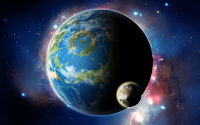 |
Orbital view rendered in Photoshop using
Equirectangular planet and moon maps |
Some of these things are possible to do without using projections, but results will vary depending on the characteristics of your map. And if you’re anything like me, the “inaccuracy” of such an approach will likely bother you, and take away from the final maps.
For Calidar, we decided from the very start to work with projections. I had long wanted to do so with my work on Mystara, but was held back by the choices of Mystara’s original cartographers back in the 1980s. This is not a criticism - on the contrary, I have the utmost respect for all of the cartographers who worked for TSR, and they have undoubtedly influenced me more than anyone else. Of course, TSR's cartographers did not have access to the kinds of computers and software that we do today, so their job was that much harder.
Working with Projections
Before computers became so ubiquitous as they are today, cartographers were forced to make difficult calculations, or to use complex tables to convert maps from one projection to another. These days, however, there is freeware software to do this for us.
The most useful I have found is NASA’s G.Projector. There is also QGIS, but it’s much more complicated and harder to use.
If you want to take full advantage of projections, there are various commercial software options to choose from too. I use Manifold, which is one of the more affordable programs. I would love to be using Avenza Systems Inc.’s MAPublisher and Geographic Imager, which enable projection and other GIS functions directly within Illustrator and Photoshop respectively, but both are well out of my price range.
Whatever software you choose, you will need to learn how to load images into it, georeference them if necessary, change projections, and then export back to your usual image format.
Projections and the World Map
For various reasons, the best projection to work with for your world map is the Equirectangular Projection. Also known as Geographic Projection, Plate Carrée, or Latitude/Longitude Projection, it is nothing more than a simple grid of latitude and longitude. This inherent simplicity makes it a relatively easy projection to work with. But it’s important to know its strengths and shortcomings.
Equirectangular Projection
+ Simple grid of latitude by longitude, giving a 2:1 ratio image.
+ The required projection for Google Earth image overlays and texturing 3D models.
+ Up is always north, left is always west, etc.
+ Low north-south distortion of shapes.
+ North-south distances are accurate throughout the map.
- High east-west distortion of shapes, progressively increasing as you move away from the equator.
- Poles are stretched across the entire length of the map, making the polar regions difficult to work with.
- East-west distances are accurate only along the equator, and difficult to measure accurately elsewhere.
Google Earth image overlays showing the original designs for Calidar's north and south poles.
The results were somewhat less than stellar. Due to this distortion, we all but abandoned polar
landmasses in the second draft. It wasn't until the fourth draft that we tackled the problem,
with the help of G.Projector and the Oblique Equirectangular Projection.
In terms of creating continental outlines, the main problem we have to deal with is the distortion of the polar areas. This is actually easy to solve, and you don’t even need to use a different projection to do so. Think about it for a moment: in an Equirectangular Projection, the equator area is relatively distortion-free. But why does the map have to be centred on the equator? In fact, it doesn’t. When you centre the map on a different parallel (or meridian!), it’s known as an Oblique Projection. What this means is that we can reproject the map to an Oblique Equirectangular Projection, so that the poles are relatively undistorted.
The same is true of any areas which need to be very specific shapes. For example, with Calidar, there are various impact craters around the world. All of these needed to be circular. It’s possible to do this simply by centring the Oblique Projection on the area of interest.
The important thing to bear in mind here is that the goal is to create a single base map. So everything that is done in a different projection must be reprojected back to the original projection, and then used as a guide to update the base map.
Using these techniques, it’s possible to build up a world which looks exactly as you want it to look.
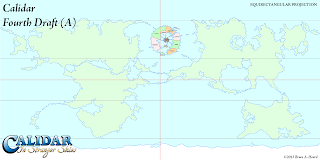 |
FIXING CALIDAR'S GREAT CALDERA
This is the fourth draft of Calidar, designed by Bruce Heard.
It's a complete rethink of the map, giving the Great Caldera
the geographical isolation that it needed. However, placing the
circular Great Caldera as is on this Equirectangular map did
not produce a perfect circle as it appeared to be. |
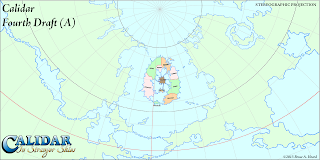 |
Here's a Stereographic Projection of the same map. You can see
how distorted the Great Caldera actually was. Even though it looked
fine on the Equirectangular map, this is how it would have looked on
the globe. |
An Example Using G.Projector
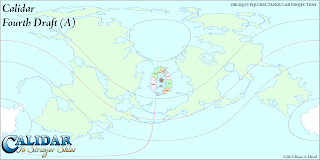 |
The first step for fixing it was to load the map into G.Projector with
default settings. Next, I changed the projection to Equirectangular
Oblique. 45ºN is about right, but the Caldera is slightly offset to
the east, so we also changed the map to 5ºE. Note that the whole
central area of the map is essentially distortion free, so the longitude
nudge was not strictly necessary. |
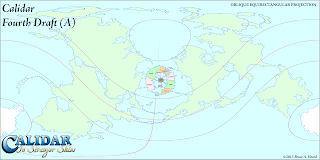 |
I took the map into Photoshop and pasted in the circular Great
Caldera. A couple of adjustments and it was done. The next
step was to load it up in G.Projector again, which meant changing
the preferences to accept our map as Equirectangular Oblique,
centred on 5ºE, standard parallel 45ºN. When loaded, the map
appeared very strange at first. You have to manually change it
to Equirectangular Oblique, at which point it displays correctly. |
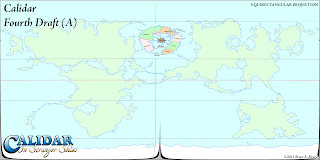 |
I entered latitude -45º to reverse the change we made before,
producing this map. As you can see, it's a little messy, so we
used this as a guide to update the previous base map. |
When you start G.Projector, it immediately asks you for a map. By default, it expects this map to be in the Equirectangular Projection. After you point it at your world map file, it then asks what coordinates the edges of the map show. G.Projector is a bit limited when it comes to loading maps other than Equirectangular full world maps, so my advice is to always work with full world maps. In that case, the default settings of 90ºN, 90ºS, 180ºW, 180ºE are perfect.
You can now reproject the map in any way you like. G.Projector's list of projections is quite extensive. Experiment and see what each projection looks like.
For building the base map, the projection we're interested in is Equirectangular Oblique. Using the latitude and longitude controls, you can specify precisely where the map is centred. For example, the default is 45º. This centres the map on an oblique line beginning at 45ºN 0ºE, circling round to 45ºS. As a general rule, everything along the centre of the map (where the equator would be on a normal Equirectangular Projection) is free from distortion. So if you want to draw a specific shape of terrain at 60ºN 35ºW, you should centre the map there.
Setting the latitude to 90º centres the map on the prime meridian. You can choose a different meridian by changing the longitude setting. This is great for working on the polar areas. (Technically this is a Transverse Equirectangular Projection rather than an Oblique one, but the difference is purely terminology.)
Output maps centred on as many regions as you need, but be sure to note the settings used in the filename for each map. You'll need this information later to reproject the map back to the base Equirectangular map.
Now use whatever image editing program you like to edit your map, only changing the central area of each map.
Loading non-Equirectangular maps, or even Equirectangular maps centred on a location other than 0ºN 0ºE, is a little clunky. You will need to go into G.Projector's preferences and input the data there. After you have changed these settings, load in your map, and you should be able to put it back to the original projection.
The final step is to use your adjusted map to update your base map.
G.Projector is limited to images around 10,000 or less pixels long, so you can't work with super high resolution images.
Also note that leaving the
graticule (the grid lines) turned on when exporting the map can be useful, but when loading the map back in the lines can become very confusing.
I'm sure this has been pretty confusing. Please give it a try for yourself, and see how it works. If you get stuck, post in the comments below and I will see if I can help you out.
Roughen outlines
So you have your world looking just as you want it. You've checked and rechecked using different projections. You've set it as an image overlay in Google Earth and navigated around your world as a globe.
Once you're sure that it's all done, the next stage is to roughen up the continental outlines. Mike Summers wrote
a wonderful tutorial for this over at the Cartographer's Guild, or you can also see it
on his blog. I don't want to steal Mike's thunder, so I will leave the details for you to discover there. I have used Mike's technique for all of Calidar's maps.
I like to roughen again at each level of detail, so I do it first at world level, then again at regional/continental level (4 times the resolution), and finally once more at local level (another 4 times the resolution).
And that brings us to the end of the continental outlines section. If you managed to read this far, thanks! There is actually one topic which I left out: scale. I have decided that it deserves a post all of its own, so I will post it at a later date.
Please feel free to post any questions, comments, or corrections in the comments below.



